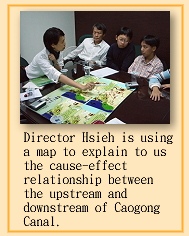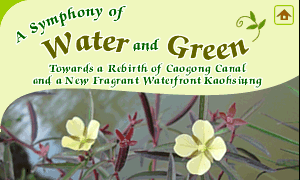Yi-chen Hsieh currently is the director of The Taiwan Wetlands Organization; she also works as a teacher. She is very familiar with the problems of Caogong Canal and has done extensive research in this area. During our second visit, Ms. Hsieh welcomed us and accepted our interview: |
Q¡GWhat exactly are the "Lost Pearls " of Kaohsiung? Why use it to describe Caogong Canal? |
A¡GWe use "Lost pearls"to describe the wetlands which were left untouched when they were developing Kaohsiung city. Caogong Canal has linked these wetlands together, and when we view them from the sky above, they seem like a necklace of pearls. This is why we call them the Lost pearls of Kaohsiung. |
Q¡GWhat is the Caogong Canal rebirth movement? |
A¡GThe early focus of change used to be the three mountains¡]Banping, Shou, and Guei mountain¡^and three lakes¡]Lotus Pond, Chen-Ching Lake, Golden Lion Lake¡^. After year 2000, several small wetlands were added into the list for improvement, such as the Niao-Song Wetland, the Yuanjhong Port Wetland, the Banhe Village Flood Detention Pond, the Neiweipi Wetland (at the Museum of Fine Arts ), and the Jhongdu Wetland. All the above wetlands have countermeasures for flooding, but their fuction mainly are wetlands. The Caogong Canal rebirth movement has a few main operations, such as increasing the aqueous space, conservation of ecosystems, improving the upstream waterways and water source, increasing area for wetland ecosystems, increasing exchange between fresh and salt water, and improvement of waterways. |
Q¡GWhy is the Caogong Canal rebirth movement related to wetland reconstruction? |
A¡GThis is because Caogong Canal is a farmland watering facility, and during periods of non-watering, Caogong Canal will not discharge any water. Yet half of Kaohsiung's wetlands come from Caogong Canal. If Caogong Canal doesn't provide water, the wetlands would dry up. This of course means they won't be wetlands any more, since you need water, plants, and mud to qualify as a wetland. The other problem is that Kaohsiung constantly floods; it was not like that in the past. Water used to seep into the dirt, but concrete is everywhere now; it will simply flow into the drains and cause flooding problems. That is why we should conserve the wetlands or build detention ponds; this is how we can save the surplus water. Caogong Canal is the water source for these wetlands and has great effects upon downstream water quality. Our government has not seriously looked into this problem, and that's why we stress the importance of the Caogong Canal rebirth movement to the government. |
Q¡GAre there any difficulties in the reconstruction of the lakes or wetlands in Kaohsiung? |
A¡GThe lakes link the wetlands together, once they are polluted, the wetlands will also be contaminated. During reconstruction, many factories dump their wastewater into the river, which in turn affects the whole water network of the Kaohsiung area. As for the wetlands, too many tourists come to visit at the same time. They should be balmed for failure of growth of plants and problems such as garbage pollution. |
Q¡GWhat conservation methods will your people employ after reconstruction of Caogong Canal is finished? |
A¡GThe conservation of Caogong Canal is much more complicated than that of the wetlands, but two of the most important issues will be to restrict the wastewater dumping and conservation of wildlife.
|
Q¡GWhy didn't the government treat Caogong Canal as a river in the first place? |
A¡GThat's because it was a manmade watering facility in the first place, and cannot qualify as a natural river. Even if it does connect the five rivers, it still doesn't qualify. However, since it links all the rivers together, if it is polluted, all five rivers connected will be affected. This is why we think it should be treated as a natural river for the sake of the wetlands it connects. |
Q¡GIf the government is willing to list Caogong Canal as a river, what qualities must Caogong Canal have? What difficulties will it face during the process? |
A¡GIn order to list it as a river, the basic requirements are to keep the water quality above B level. There have been many times when we almost achieved B level, a factory dumped their wastewater into Caogong Canal, which forced us to do it all over again. |
Q¡GIf the factories are prohibited to dump water into Caogong Canal, they might dump it somewhere else. Has the government thought and done anything about that? |
A¡GThe government currently is constructing wastewater pipes, but it takes more time and money to build these systems. Approximately 60% have already been in use, so it's less likely that they would dump wastewater illegally anymore. |
Reflection 
Director Hsieh is a very remarkable woman, the rebirth of wetlands in Chouchai and Caogong Canal are all under construction under her influence. During this meeting, we understood the importance of Caogong Canal. Although its importance is not as crucial as it was before. Yet if we forget to conserve Caogong Canal, it will cause devastating effects to the water networks in Kaohsiung. That is why we have to understand the importance of the Lost Pearls, and come up with a plan that will last and reveal the beauty of this city. |

